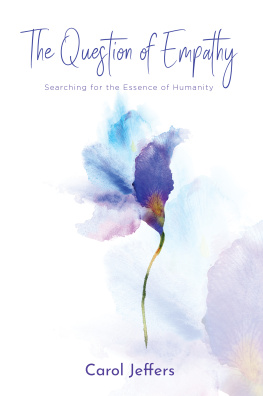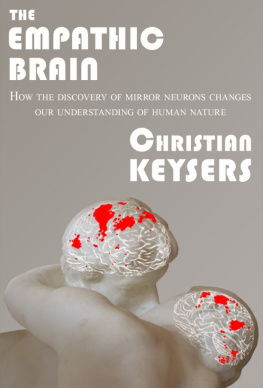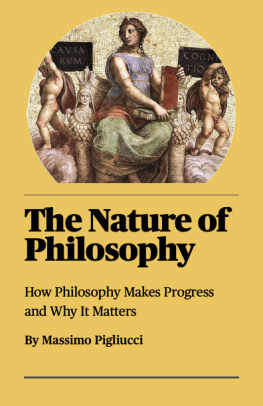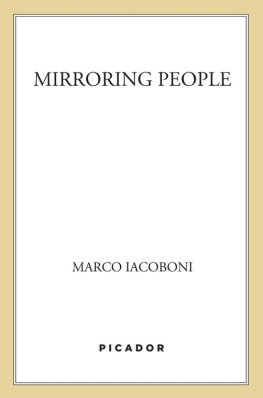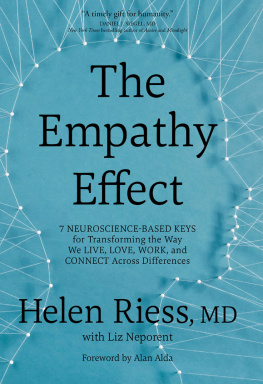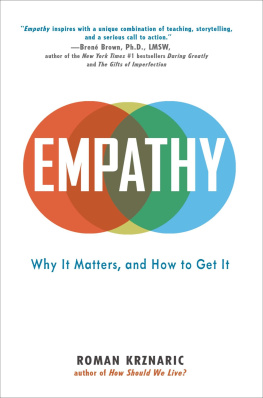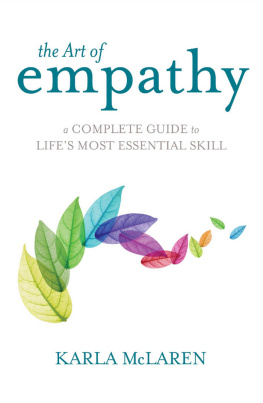
The Question of Empathy:
Searching for the Essence of Humanity
by Carol Jeffers
Copyright 2018 Carol Jeffers
ISBN 978-1-63393-669-0
All rights reserved. No part of this publication may be reproduced, stored in a retrieval system, or transmitted in any form or by any meanselectronic, mechanical, photocopy, recording, or any otherexcept for brief quotations in printed reviews, without the prior written permission of the author.
Published by

210 60th Street
Virginia Beach, VA 23451
8004354811
www.koehlerbooks.com
To Marcus, my grandson,
who was born with empathy
and
To Gene, his grandfather
who nurtured it
I believe empathy is the most essential quality of civilization.
Roger Ebert
Chapter I
In the Rhizome
Strolling among the dunes and driftwood, and the mock heather and yarrow of Moonstone Beach on Californias Central Coast, you are likely to come across a humble wooden bench made remarkable by what it declares, by the empathy it stirs, and by the stories it invites us to share. Rough and weatherworn, the bench is evocative of the salt air and wild daisies, the restless tides reshaping the continents rocky edge, and the wide sunset views it is meant to afford. But it has become legendary and invokes much more than a simple seascape. From its niche in the coastal ecosystem, this bench triumphs in returning us to the cultural sphere, to the human hands that created and mounted a small plaque to the backrest, and to the soul forever inhabiting the carved letters proclaiming, I shall always love a purple iris. Like the bench itself, the thought is at once simple and elegant, forthright and mysteriousa paradox, to be sure, but also a metaphor for that innate capacity enabling us to wonder, to imagine, and thus, to empathize.
If the plaque captures your imagination, as it has mine and others, judging by Internet postings, then you may wonder whose words these are. Full of whimsy, or poignancy, or both, they resonate and inscribe themselves upon our hearts. Who is it that we have to thank for this unexpected delight and for the images it inspires, the stories it prompts? What is the meaning, symbolic or otherwise, of the flower we imagine, springing from its rhizomic underground network to be capped off by its distinctive beard, caterpillarlike and golden in the April sun? Or maybe we envision a couple who once shared the bench. Is she gone now, his purple iris? What was her story or his? Theirs? What is ours? We might ask that last question as each of us takes a small part in creating this larger narrative, one echoing beyond the beach itself. And where might that narrative take us?
Each time I return to Moonstone, the bench reminds me of the story always unfolding even as it retells itself, an ever-expanding narrative that begins with our shared curiosity and appreciative smiles and builds to the empathic response that connects us all to the spirit of the plaque and the mystery of its maker. I watch as others pause to read the line, then turn from it slowly, thoughtfully, before continuing on to the observation point, where the best views of the otters and seals are to be had. I wonder what images, what stories the benchour shared touchstoneconjures up in them.
Perhaps there are those weekenders who, like me, envision a loved onean uncle, in my casewho cherished their iris beds, tended them faithfully through the summer and fall, and patiently awaited the blossoms, lavender and lovely, in the spring. Or perhaps they think of their children who, like my own, found the quivering petals fascinating and delighted in stroking the fuzzy beards. I wonder too if upon their return to the routines of the workweek, these weekenders might Google the benchs poetic proclamation and come across the image of two purple irises, one pinned on each side of the plaque. If they do, perhaps they too will savor the moment and its mystery, even as they wonder about this online tribute and the new connections and stories it encourages.
Like the iris rhizome itself, these connections are bound to crisscross, to entangle and create an unruly latticework of horizontal stems with their all-important nodes sending out new roots and shoots that allow for more connections still. And like those in the botanical sphere, connections of the cultural kind are often random, sometimes serendipitous, and always meant to replenish the rhizome, if not to expand its reach. As a professor of art education, I find that my stories and images of the Moonstone bench are tightly intertwined with Van Goghs Irises (1889), which, in turn, overlap with former students experiences of the painting. I envision the canvas at the Getty Center in Los Angelesits stunning blues, violets, electric aqua, a splash of whiteleaping from the museum wall. In the perpetual crowd gathered before it, I imagine my students over the years, so many resonating with the artists work and poignant life story. They read the wall text and learn that Vincent began the painting upon his arrival at the asylum in Saint-Rmy-de-Provence in May of 1889, and they almost always agree with brother Theos assessment that the composition, bursting with more than two dozen purple irises, a solitary white one among them, is filled with air and light.
In another instant, I am whisked off to the South of France where I follow Van Goghs path, hiking the trail that led him and the pain he carried from the center of Saint-Rmy past a mulberry tree still young in his day, past the stone farmhouses, old even then, past the dark-green cypress trees and pale-gold wheat fields rising up to meet the asylum on top of the ridge. I stand in Vincents meager cubicle of a roomor one very much like hisand look out the window at the garden below. The lavender beckons now, but I imagine the irises that bloomed a month or two earlier and try to get a sense of what he saw, a feel for his world in Provence in what turned out to be the last year of his life.
In still another image, I am back in the classroom, drawn into one of my students assignments. Christina, a twentysomething prospective elementary teacher, is explaining to the class why she has chosen Van Goghs Irises to serve as her personal metaphor. While growing up, the wistful Christina tells us, she had always felt different from everyone elsea painful, sometimes humiliating and always lonely experience for her. But now that she is older, she sees herself as the white iris: unique, but not alone, a part of the iris gardens beautiful air and light. Holding up her reproduction of the painting, she smiles and says she is proud of her individuality, her identity, just as she is proud to be a contributing member of the group. Her classmates smile back, an affirmation welcoming her into their purple midst, and I am convinced that Christina will always love a white iris.
What is this wonder that allows us to connect across time and space or to connect at all? What allows uscompels us, evento snatch these existential moments from afar, from across the room and hold them close? They are as random as they are resonant, and somehow these empathic tangles twist within our corporeal and spiritual beings, knotting the two together.
If the answer lies matted in the rhizome, then we must also acknowledge that bamboo and crabgrass are part of this metaphor, their crisscrossing roots and shoots bound to complicate the question of empathy. Are we meant to see ourselves, backs bent, brows sweating, chopping back the bamboos unruly growth? Must we remember the knuckles bloodied again and again clawing at the stubborn crabgrass, or are there other metaphors to raise us from our knees, free us from the paradox that gives the benchs purple iris its certainty and uncertainty? Perhaps we could tell different storiestales of wizards and incantations, saythat cast us into a land beyond the rhizome. Or we might share different images of miners digging into the depths, detectives searching for clues, all intent upon unearthing the wonders of human connection.

